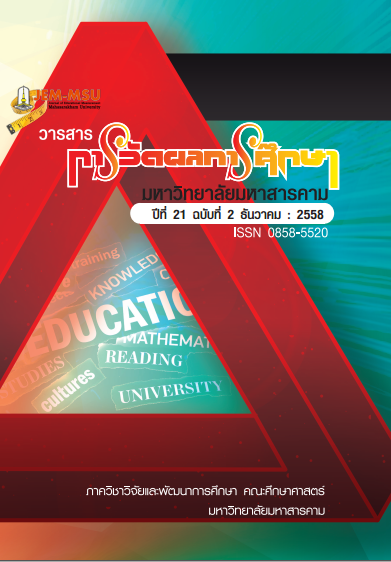Comparisons of Learning Achievement on A Linear Equation in One Variable of Matthayomsuksa 1 Students between Group Collaboration Learning Management with STAD Technique and Regular Learning Management
Main Article Content
Abstract
The purposes of this research were : (1) to develop the lesson plans of Group
Collaboration Learning Management with STAD Technique on A Linear Equation in One
Variable of Matthayomsuksa 1 Students to have the efficiency criteria of 75/75, (2) to
fine the effectiveness index of Group Collaboration Learning Management with STAD
Technique lesson plans and Regular Learning Management lesson plans on A Linear
Equation in One Variable of Matthayomsuksa 1 Students, (3) to compare the learning
achievement and the process skills on mathematics, A Linear Equation in One Variable
of Matthayomsuksa 1 Students between Group Collaboration Learning Management
with STAD Technique and Regular Learning Management, and (4) to study the students’
satisfaction their learning activities by using Group collaboration Learning Management
with STAD Technique. The sample groups were 80 students of Matthayomsuksa 1,
Nongkungsriwittayakarn School, Nongkungsri district, Kalasin province by cluster
random sampling. Four types of the instruments used in the study were. They were :
(1) one hour lesson plan of The Group Collaboration Learning Management with STAD
Technique and one hour lesson plan of Regular Learning Management for 18 lesson
plans of each techniques. It had results of the evaluation by experts. Overall average
4.52 are the most appropriate level and 4.47 are appropriate level respectively ; (2)
The test achievement on learning, it was 40 four-alternative item. It had a difficulty
value (P) ranging 0.33 - 0.75, the discrimination of each items (B) ranging 0.44 - 0.79 and
the reliability of all the items was 0.88 ; (3) The test of measurement on mathematics
process skills, it was 25 four-alternative item. It had a difficulty index (P) ranging 0.30-
0.75 and discrimination (r) ranging 0.40-0.90 The reliability of all the items was 0.85 ;
and (4) The satisfaction of student test on their learning activities were 20 items. They
were rating scales which had the discriminating of all the items from 0.54 - 0.91, the
reliability was 0.96. The statistics used for analyze the data were ;a percentage, a
means, a standard deviation and hypothesis test, by using Hotelling’s T2
The research results were as follows :
1. The lesson plans of Group Collaboration Learning Management with
STAD Technique and Regular Learning Management, the efficiencies were 85.34/84.63
and 83.81/75.94, respectively. It was higher than the setting criteria of 75/75.
2. The effectiveness index of lesson plans of Group Collaboration
Learning Management with STAD Technique and Regular Learning Management were;
0.7490, it was 74.90 percent and 0.6432 it was 64.32 percent, respectively.
3. The students who had the lesson plans of Group Collaboration Learning
Management with STAD Technique, they had higher learning achievement and higher
process skills on mathematics than the students who had Regular Learning Management,
statistically significant at 0.01 level.
4. The students who had Group Collaboration Learning Management with
STAD Technique had the total level of more satisfaction.
Article Details
The content and information contained in the published article in the Journal of Educational Measurement Mahasarakham University represent the opinions and responsibilities of the authors directly. The editorial board of the journal is not necessarily in agreement with or responsible for any of the content.
The articles, data, content, images, etc. that have been published in the Journal of Educational Measurement Mahasarakham University are copyrighted by the journal. If any individual or organization wishes to reproduce or perform any actions involving the entirety or any part of the content, they must obtain written permission from the Journal of Educational Measurement Mahasarakham University.


